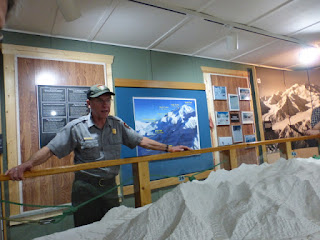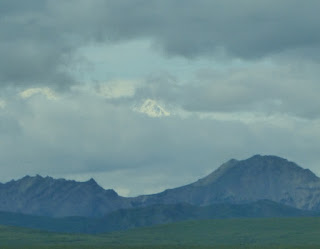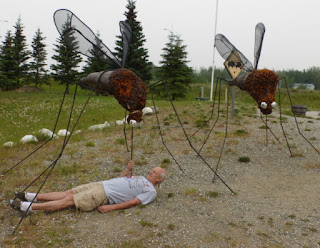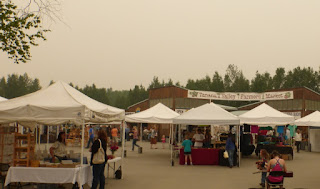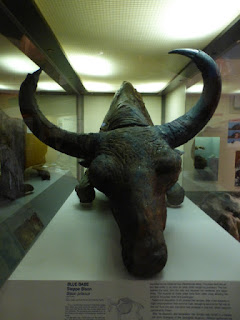Sunday, 28JUN, we
headed south. We wanted to spend the
night at Trapper Creek, AK, but no room at the RV park chosenL. They directed us to one 17 miles down the
road. After setting up camp we
immediately jumped into the Toad & headed back to Talkeetna, AK (located at
the end of a 14 mile dead end road off the main highway).
We immediately
noticed the town was overrun with day tripping tourist; & bus upon bus of
cruise ship passengers from AnchorageL. Talkeetna
used to be known as a “laid back” community, where lots of mountain climbers
used to hang out. Now it is well on its
way to being just another place where tourist feel they have to go on their
visit to AK.
We made every effort to stay far from the maddening crowd & experience the old Talkeetna. There was no on street parking left, but Dan noticed the local museum had an empty “customer” parking lot. Since we were going to visit it anyway, we parked there. We ran into the museum to find out where in town the daily Denali (mountaineering) Ranger presentation was held at 1PM. Turns out it was in the museum! And for $3 each we got all day parking, access to the Ranger talk, plus access to the museum:)!
We made every effort to stay far from the maddening crowd & experience the old Talkeetna. There was no on street parking left, but Dan noticed the local museum had an empty “customer” parking lot. Since we were going to visit it anyway, we parked there. We ran into the museum to find out where in town the daily Denali (mountaineering) Ranger presentation was held at 1PM. Turns out it was in the museum! And for $3 each we got all day parking, access to the Ranger talk, plus access to the museum:)!
The Ranger
presentation was by Roger Robinson who has been a mountaineer for almost 40 years,
& a Denali (mountaineer) Ranger for over 30. He didn’t have a prepared talk, but just
started off with general info on climbing Denali, & talked further about
any questions asked. It was not a direct
presentation, but it was fascinating!
We won’t go into the
“gross” details, but someone asked about how “polluted” the climbing route on
Denali is today. We were all surprised
by his answer that the Denali climbing route in the 70s/80s was the most
polluted part of any National Park in the USA.
Climbers would literally dump all their trash (& even their gear) at
17,000 feet after summiting so they wouldn’t have to carry it down. Sometimes they would throw it in a
crevasse. Sometimes they would pile it
all up, pour all their remaining fuel on it, & burn it – then the wind
would blow the ash over hundreds of square yards, where it remained in the snow
for years.
Lastly let’s not
talk about the high rates of dysentery at 17,000 ft & the glacier airfield,
because of fecal coliform poisoning.
This was because of non-existent safe sanitary practices. Ranger Robinson also stated that the 20 &
30 year old climbers of today are much more environmentally sensitive than us
baby boomers (so much for the Earth Day generation).
When Robinson
started there were two rangers assigned to Talkeetna; one to manage climbing
permits & one to address issues on the climbing route. Obviously not enough Rangers! Today there are nine Rangers in Talkeetna; &
one of these Rangers & 4 volunteers (ie experienced mountaineers) are
stationed at 14,200 feet for a month at a time.
They manage the constant stream of climbers during climbing season,
& are stationed there for emergencies.
Then it was off to the Ranger Station to view the 17 minute movie on
climbing Denali (excellent).
Trivia – what is a
Clean Mountain Can, & who invented it?
Corrie then went
exploring the shops of Talkeetna, while Dan went back to the Museum to view
their exhibits. While Dan was standing
in the museum parking lot a bush plane literally flew over Dan’s head, almost
clipped parked cars, & landed on a grass airfield at the end of D
Street. Turns out this is the town’s
airfield, & the pilot was practicing landings & take-offs.
We then got together at the Talkeetna Roadhouse for lunch/dinner. Corrie had the mushroom quiche w/Hungarian mushroom soup, Dan had reindeer meatloaf slider w/reindeer chili – two thumbs up!
We then got together at the Talkeetna Roadhouse for lunch/dinner. Corrie had the mushroom quiche w/Hungarian mushroom soup, Dan had reindeer meatloaf slider w/reindeer chili – two thumbs up!
From Talkeetna we
back tracked to Trapper Creek, AK. There
we explored Wal*Mikes, a roadside attraction we had passed on our earlier drive. Later that evening while walking Gumbo we
noted several fisherman at the Montana Creek next to the RV park. From the adjacent walking bridge we could
clearly could see big king salmon making the journey to their spawning grounds. A very moving sight, too bad we no longer see
this in the lower 48. In the RV park we discovered we had
1G cell phone coverage. This is ok for
phone calls & texts, but forget any use of data!








